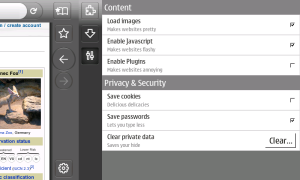Author: Nathan Willis
Mozilla released the first workable alpha version of its new Fennec mobile browser last week, showcasing a new interface optimized for small-screen devices. Despite the slimmed-down look, however, Fennec makes use of the same Mozilla technologies under the hood that are well-known in Firefox. In my testing on my own handheld device, I found Fennec an enticing browser with a well-thought-out interface.
The Fennec project is neither the first nor the only Mozilla-derived browser built for mobile devices. Nokia maintains the MicroB browser for its Maemo platform Internet tablets, and a now-defunct project called Minimo was once developed for Windows Mobile phones. But Fennec is different in that it is an official Mozilla project, and it incorporates more than just the Gecko rendering engine. Fennec will support standard pieces of the Firefox experience like JavaScript, XUL, plugins and extensions, and even recent additions like Awesomebar.
You can grab the first usable release from the Fennec project site on Mozilla Labs. A Web-installable build for Maemo tablets is provided, as are builds for Mac OS X, Windows, and desktop Linux. The release notes indicate that the Maemo build is targeted at the N810 line of tablets, which feature a hardware keyboard, but I did not have any trouble installing or running the package on an N800.
Interface, not in your face
Perhaps the most innovative feature of Fennec is its user interface, which attempts to maximize the amount of screen real estate devoted to page rendering. It does so with context-sensitive UI elements and off-screen controls that you access with gestures.
The browser’s start page shows first-time users what to do — slide left to reveal the toolbar that rests just out of sight on one side; slide right to reveal the tab bar, which sports page thumbnails instead of text titles. The location bar at the top of the window is minimalist, sporting only a favicon, reload button, and bookmarks button.
In addition to the side-accessible toolbars, Fennec attempts to make getting to the desired URL as fast as possible by incorporating URL completion and search into the text entry. URL completion works much like it does in Firefox 3’s Awesomebar, bringing up a list of matches on both address and page title, and adjusting the list as you type. For faster search, start typing your search terms in the location bar, then click on one of the search buttons at the bottom of the pop-up window.
I shall call him Mini Fox
A Fennec, in case you were wondering, is a pocket-sized species of fox native to northern Africa. Like its namesake, the Fennec browser is a miniaturized version of Firefox, not a stripped-down, lightweight alternative.
Consequently, it includes features not commonplace on the mobile browsers found on many phones, such as Firefox’s management of downloads, cookies, passwords, and certificates, full support for AJAX Web pages, and tabbed browsing. It also includes support for extensions, plugins, and themes, and integrates with Mozilla’s online services such as update notifications and Weave online bookmarking and personalization.
But the project’s vision statement also includes mobile-friendly ideas not found in desktop Firefox, such as geolocation, initiation of phone calls from within Web pages, and integration with PIM services on the device.
Performance
In my tests, Fennec is — not surprisingly — slower than MicroB on the N800 tablet. Some N800 users reported problems using the device’s software keyboard, but I did not have trouble.
As for Fennec’s user interface, the hidden tool and tab bars are easy to get used to, but I found it all too easy to accidentally slide them into view while scrolling a page up and down with the stylus. If you use an N810 device with a keyboard, you may be able to scroll with hardware keys, avoiding the issue, but with a touchscreen device that is unlikely to be the preferred way of navigating.
On a side note, it took me a few pages to realize that Fennec recoups some screen space by eliminating the traditional scroll bar altogether. I don’t know if the space savings are worth it, considering that without a scroll bar you lose the ability to tell where on the page you are.
The rest of the interface is slick. I found the location bar autocompletion and search fast and unobtrusive, and liked the thumbnail view of the tab bar. There are no themes or other add-ons for Fennec yet, but since it employs the same APIs as Firefox, they are sure to follow.
It is good to see Mozilla putting significant resources and effort into the mobile space. Mozilla changed the desktop browser marketplace; I hope its influence on mobile browsing will be even bigger.
Categories:
- Reviews
- Internet & WWW
- Handheld Devices




